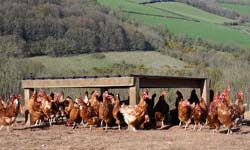
The area of shade required for birds on range is set to double.
Freedom Food standards already include the new regulation—which comes into force on 1 June. And the Soil Association is set to introduce the same ruling, combined with a requirement for aerial perches.
The amount of overhead shade will increase from 4 square metres per 1,000 birds to 8 sq. metres. Freedom food says this can either be natural, or artificial or a combination of both. The standards make no reference to the obvious differences in natural shade between the leaf coverage available in summer and winter.
The Soil Association is opting for the same amount of shade—4 sq. metres per 500 birds. Its proposed new standard, which it is thought will come into force in January 2008, says: "You must be able to demonstrate that you encourage your poultry to range by providing enough cover to imitate their native habitat and encourage them to range fully. This can be either natural, such as trees, shrubs and cover crops, and/or artificial such as screens and trailers."
But producers who are both Freedom Food and Soil association could face a conflict. FF says the shelter must be 30-35 metres from the house. The SA says it must be within 25 metres of the house.
Aerial perches should have been a requirement throughout the UK by now under the terms of the Welfare of Laying Hens Directive. But delays in the review of the Directive means that the requirement has not yet been triggered except in Scotland and Northern Ireland where the authorities no longer accept the concept that perches can be built into slats.
The Soil Association is now pressing ahead with a perching requirement for the whole country. It will demand 18cm of per space per bird and 15cm for pullets. The first perch must be at least 10cm from the ground and the distance between perches must be 45 cm vertically and 30cm horizontally. These requirements are currently out for consultation and are also expected to be brought in next January. Producers will have to carry out the work ahead of a new flock arriving after that date.
Scottish organic producer Giles Henry has already had to install perches. He says: "Our main concerns were that of the perch structures restricting us from walking through the flock and also presenting difficulties in cleaning down on depletion—and of course expense.
"But the benefits we have seen since fitting the perching far outweigh any difficulties that they have thrown up. Welfare of the birds has improved, nest boxes are cleaner and there is an improvement in egg quality.
"We now get very little bullying because any birds that are being bullied can now get away from other birds by remaining up on the perches.
"As all the birds are perching at night and also using the perches through the day, then birds are not perching on the front of the nest boxes and therefore the nests are not getting dirty. Egg quality, at least so far as external appearance goes, is also better."
